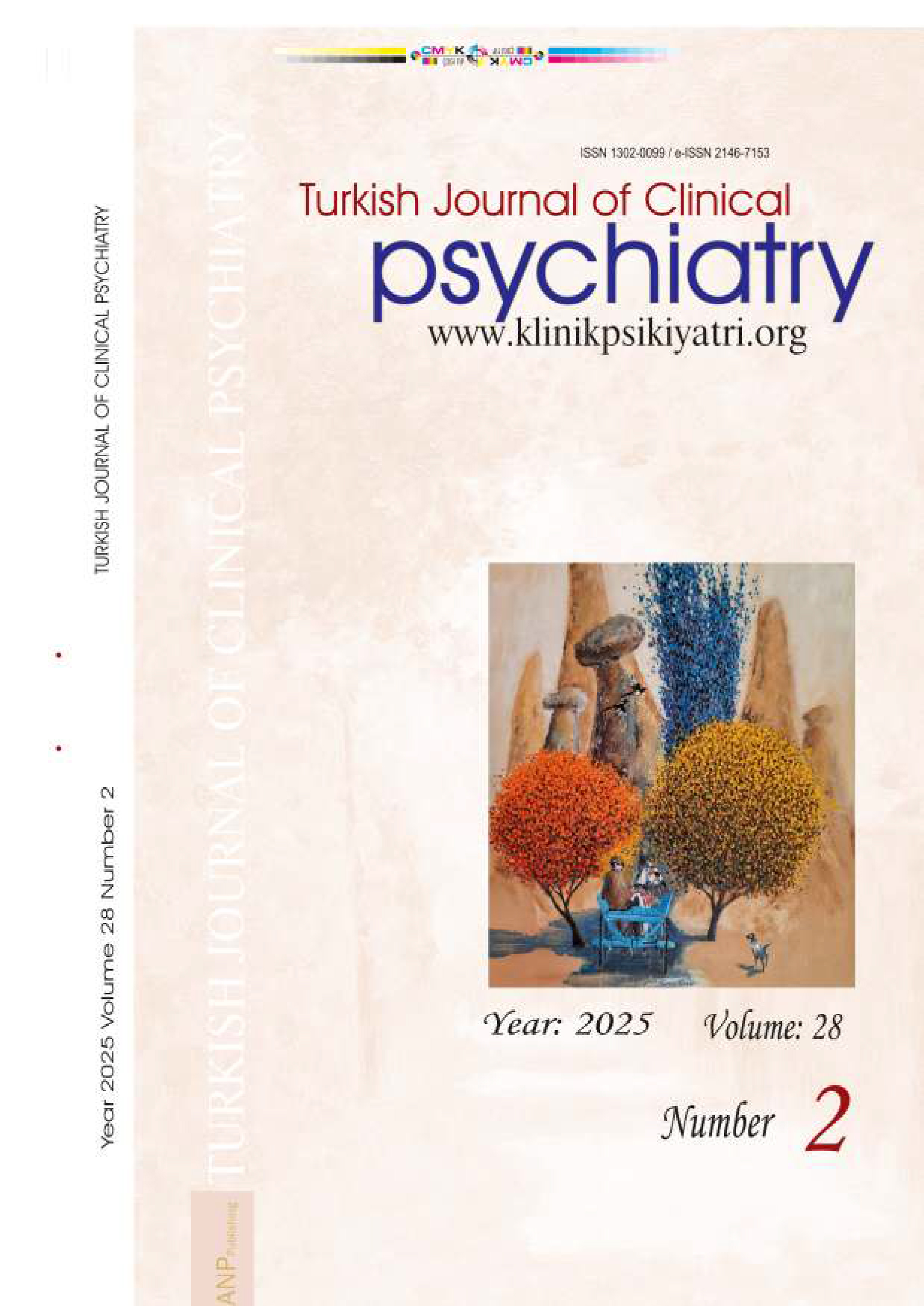





Volume: 26 Issue: 1 - 2023
| EDITORIAL | |
| 1. | Disasters, Psychiatry and Mental Health Mehmet Hamid Boztas, Ejder Akgun Yildirim doi: 10.5505/kpd.2023.40374 Pages 5 - 8 Abstract | |
| RESEARCH ARTICLE | |
| 2. | Does chronobiological preference affect the clinical appearance of obsessive-compulsive disorders? Ayşe Sakallı Kani, Uzay Dural, Volkan Topçuoğlu, Kemal Sayar doi: 10.5505/kpd.2023.05826 Pages 9 - 18 INTRODUCTION: There is a growing body of evidence supporting the involvement of circadian rhythm abnormalities in the psychopathology of obsessive-compulsive disorder. However, the effects of chronotype preference on the clinical features of this disorder are elusive. The aim of this study is to investigate how chronobiological predispositions of people with obsessive compulsive disorder affect obsessive compulsive disorder symptomatology, age of onset, course of the disease and accompanying comorbid conditions. METHODS: Within this cross-sectional study, 76 participants with mean age of 32.53, who have been under treatment with a diagnosis of obsessive-compulsive disorder, were evaluated. Sociodemographic and clinical data form, Yale-Brown Obsessive Compulsive Scale, Morningness and Eveningness Questionnaire, Hamilton Depression Rating Scale, and Hamilton Anxiety Scale were applied to the participants. RESULTS: 65.8% (n=50) of the participants consisted of women. Mean age of onset is 18.74 ± 9.36 years. Most of the patients were reactive type (n= 47, 61,8 %). Most common obsession type was contamination (n=53, %69,74), the most common compulsion type was cleaning/washing (n=52, %68,42). There was no significant correlation between morningness and eveningness scale scores and obsession and compulsion types. No significant correlation was found between morningness and eveningness scale scores and OCD onset age. There was no significant difference between morningness and eveningness scale scores according to the OCD type of the patients and the presence of accompanying clinical diagnoses. DISCUSSION AND CONCLUSION: Morningness or eveningness chronotype tendencies did not have a significant impact on the clinical appearance of OCD. |
| 3. | Are the consequences of substance use disorder more severe than schizophrenia?: Effects on the mothers and the patients Meltem Saraçoğlu, Demet Atlam, Betül Akyel Göven, Zeki Yüncü doi: 10.5505/kpd.2023.57873 Pages 19 - 27 INTRODUCTION: The aim of this study is to examine effects the mental disorder on the patients and their mothers. Also it was aimed to evaluate the patients in terms of internalized stigma, and their mothers' in terms of beliefs about the illness and their mental status as hopelessness, depression, burnout levels. METHODS: Participants with SUD (n=30), SCH (n=30), control group (CG) (n=30) and all their mothers (n=90) were included in the study. Pearson chi-square, t test, ANOVA, Dunnet's C post hoc and Scheffe post hoc tests, effect size test eta squared (η2) and Pearson correlation tests were used. RESULTS: Internalized stigma of patients were similar, different from CG. Depression and burnout levels of mothers of patients with SUD were higher than other groups. The depression levels of mothers were significantly different and had a large effect. Hopelessness was higher in mothers of SUD patients than mothers of CG. The relationship was found between SUD patients’ mothers' depression, hopelessness, burnout and their negative beliefs toward MI. DISCUSSION AND CONCLUSION: It is seen that the presence of MI has a huge impact on self-stigmatization of the patient and depression, burnout and hopelessness in their mothers. SUD effects on the mother are more severe. Mental health of the mothers affects their perspectives on MI. |
| 4. | Screening for cognitive impairment in schizophrenia: A comparison between the Mini-Mental State Examination and the Montreal Cognitive Assessment Test Selma Ercan Doğu, Ahmet Kokurcan doi: 10.5505/kpd.2023.67760 Pages 28 - 36 INTRODUCTION: Cognitive impairment is a core feature affecting social and occupational functionality in schizophrenia. The aim of this study is to compare the Mini-Mental State Examination (MMSE) and the Montreal Cognitive Assessment (MoCA) in screening for cognitive impairment in individuals diagnosed with schizophrenia and to examine the relationship between neurocognitive functions and clinical symptoms. METHODS: The study included 135 individuals with schizophrenia followed in Ankara Dışkapı Community Mental Health Centre. Sociodemographic Data Form, Brief Psychiatric Rating Scale (BPRS), The Scale for The Assessment of Positive Symptoms (SAPS), Negative Symptoms Assessment Scale (SANS), MMSE and MoCA were administered. RESULTS: The mean MMSE score was 25.64 ± 2.72, and the mean MoCA score was 17.91 ± 3.83. There was a high positive correlation between the MMSE and MoCA scores (r=0.667). The MMSE and MoCA tests showed a substantial difference in the assessment of cognitive functions; and MoCA was found more sensitive than the MMSE in determining cognitive impairment. Moreover, the MMSE and MoCA scores showed a negative correlation with the BPRS, SANS, and SAPS scores. DISCUSSION AND CONCLUSION: These findings indicate that MoCA may be used as a more useful screening test for cognitive impairment in people with schizophrenia. |
| 5. | Predictability of depression by plasma low-grade inflammatory markers in the background of Pediatric Celiac disease Ayşegül Efe, Ayşegül Tok doi: 10.5505/kpd.2023.23471 Pages 37 - 46 INTRODUCTION: Previous hypothesis on the predictability of either psychopathological or chronic metabolic disorders by complete blood count (CBC)-derived, low-grade peripheral inflammatory indicators should be considered with caution given the discrepancies in earlier findings. We aimed to examine the predictability of depression with low-grade inflammatory indices in a background of celiac disease (CD) and the association with gluten-free diet compliance by a case-control study in a pediatric sample. METHODS: A total of 59 children with a biopsy-proven CD were mainly compared with 40 controls in terms of depression and anxiety symptoms, as well as global functionality and CBC-derived indices which the previous studies focused on. Laboratory findings and psychiatric symptoms were examined through subgroups by either depression or gluten-free diet (GFD) compliance. RESULTS: Prevalence of depression was 34% in the celiac group and there was a perpetual association of depression with CD. However, none of the CBC-derived indices investigated in earlier studies of either depression or CD was found to be differed by the presence of CD, depression, or status of GFD compliance. DISCUSSION AND CONCLUSION: Despite the presence of strong evidence for the role of inflammation on the prevalent comorbidity of depression with CD, the impact of inflammation on the depression-CD relationship was not demonstrated on these subjected markers which have been previously recommended as good indicators of systemic inflammation, however, with a low level of evidence and contradictory findings on predicting inflammation. The predictability of psychiatric and metabolic outcomes based on chronic inflammatory conditions with these CBC-derived indices requires further investigation. |
| 6. | Intimate partner violence during the COVID-19 pandemic: An online survey Ekin Sönmez Güngör, İmran Gökçen Yılmaz Karaman, Burcu Rahşan Erim, Hasibe Rengin Güvenç, Ceylan Ergül, Kerem Laçiner, Gamze Akçay Oruç, Fatmagül Dikyar Altun, Arzu Erkan, Gamze Erzin, Ebru Toprak, Yıldız Akvardar doi: 10.5505/kpd.2023.85126 Pages 47 - 59 INTRODUCTION: Intimate partner violence (IPV) against women is a human rights violation and a public health concern. The incidence of IPV increases in mass events such as epidemics. The aim of this study was to assess the nature and the extent of IPV among women in Turkey; to identify the associated factors, and mental health outcomes during the COVID-19 pandemic. METHODS: The study has a cross-sectional, descriptive design. An online self-report survey, based on World Health Organization guidance on epidemiological studies to assess IPV, was conducted among women between 09.01.2021 and 09.02.2021. The survey had 69 questions which covered sociodemographic characteristics, relationship history, types of violence and mental well-being. Inclusion criteria were being over the age of 18, and having a spouse/partner during the pandemic. Participation was on voluntary basis. 1372 women were included in the analysis. RESULTS: Around a third (30.7%) of participants were exposed to any type of violence before the pandemic, with most common form being emotional violence, and this rate remained unchanged during the pandemic, despite the time spent with partners were expected to increase due to isolation measures. 61 women (4.4%), mostly university graduates living in cities, reported being subject to violence for the first time during the pandemic. 31.2% of them were cases of digital violence. Lower level of education, younger age and partner’s alcohol and substance use was associated with IPV, and IPV was associated with poorer mental well-being. DISCUSSION AND CONCLUSION: Despite the public health measures taken during the pandemic (e.g. lockdowns), where women would have spent more time isolated with their partners, rates of IPV did not change from pre-pandemic to pandemic. This outcome needs to be compared with findings from other contexts. Strategies to prevent IPV is of utmost importance for the protection of mental well-being of women and the society during and after the pandemic. |
| 7. | The relationship between internalized stigma and coping strategies in bipolar disorder Zeynep Çalışkan İlter, Sıdıka Baziki Çetin, Evrim Özkorumak, Ahmet Tiryaki, Ismail Ak doi: 10.5505/kpd.2023.93265 Pages 60 - 68 INTRODUCTION: The aim of this study was to evaluate the relationship between internalized stigma and coping attitudes in patients in remission of bipolar disorder. METHODS: The study included 77 patients in remission who were diagnosed with bipolar affective disorder according to DSM-IV by applying the Structured Clinical Interview for DSM-IV Axis I Disorders (SCID-I). Euthymia was established using the Young Mania Rating Scale and the Hamilton Depression Rating Scale. All patients were evaluated with a Sociodemographic Data Form, the Internalized Stigma in Mental Illness Scale (ISMI) and the Coping Attitudes Rating Scale (COPE). RESULTS: The perceived discrimination subscale scores of patients living in towns/villages were found to be significantly higher than those living in urban areas (p=0.038). A positive correlation was found between the total number of episodes (10.0±10.8), the number of depressive episodes (3.7±4.8) and the history of depression with psychotic features and internalized stigma. Patients showing active coping, planning, use of useful social support, positive reinterpretation and development of coping styles were found to have lower internalized stigma scores and higher stigma resistance; moreover, patients using behaviorally disengaged coping styles had higher internalized stigma scores and lower stigma resistance. DISCUSSION AND CONCLUSION: According to the results of our study, active coping, planning, use of useful social support, positive reinterpretation and support of developmental coping attitudes, which are among the functional coping attitudes, and attempts to reduce the behavioral disregard of maladaptive coping attitudes can be targeted to reduce internalized stigma. |
| CASE REPORT | |
| 8. | A case of adult-onset metachromatic leukodystrophy beginning with behavioral symtoms Hazan Tunalı, Süheyla Ünal, Ceren Acar, Emel Sağlar Özer doi: 10.5505/kpd.2023.43402 Pages 69 - 75 Metachromatic leukodystrophy is a rare inherited disorder of the nervous system with great clinical variability characterized by loss of both cognitive and motor functions upon extensive white matter damage by the accumulation of sulfatides. Although metachromatic leukodystrophy usually affects children, many cases of adult leukodystrophy have been reported in the literature in the last few years. Adult-onset leukodystrophy typically presents with a progressive syndrome that includes various combinations of cognitive impairment, spasticity, apraxia, ataxia, and upper motor neuron manifestations. In this article, we decided to present this case to draw attention to the fact that the adult form of metachromatic leukodystrophy, which presents with psychotic symptoms and behavioral problems, should be considered in the differential diagnosis of psychotic pictures. In a 48-year-old male patient who did not have any psychiatric or neurological problems before, symptoms such as meaningless shouting, running away from home, restlessness, and audio-visual hallucinations were added to the clinical picture that started with confusion and disorganized behavior in a short time. MRI, plasma aryl sulfatase A level (ARSA) and gene analysis were performed for differential diagnosis in the patient. It is known that the patient has a sibling who died before the age of one, and two nephews diagnosed with autism spectrum disorder. Heterozygous c.1283C>A (p P428Q) mutation was detected in the patient, which was not previously reported in the literature or mutation databases. The chromosomal region-22q13.33- in which the ARSA gene with this mutation is located is also a candidate region for autism. In this respect, it was thought that this mutation might be related to disorganized behavioral problems. |










